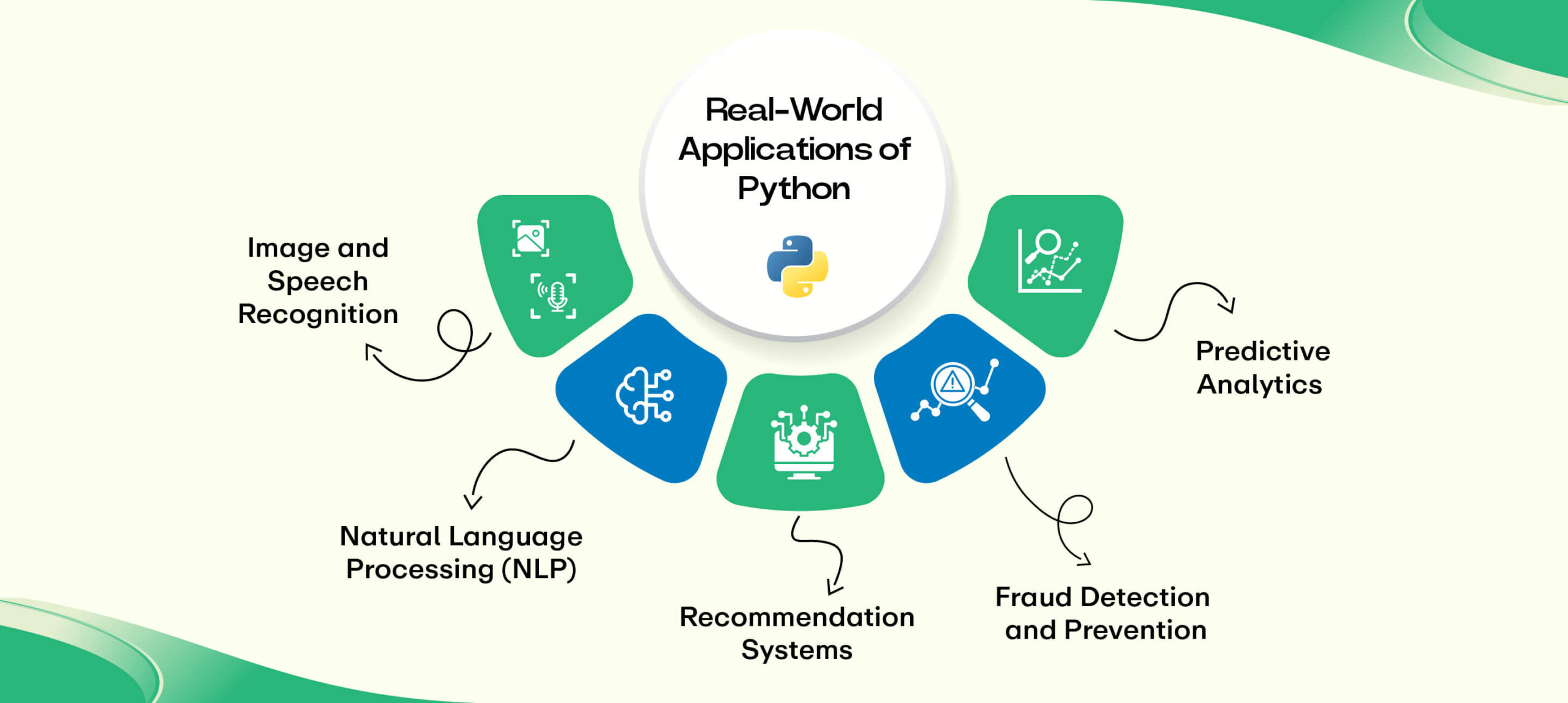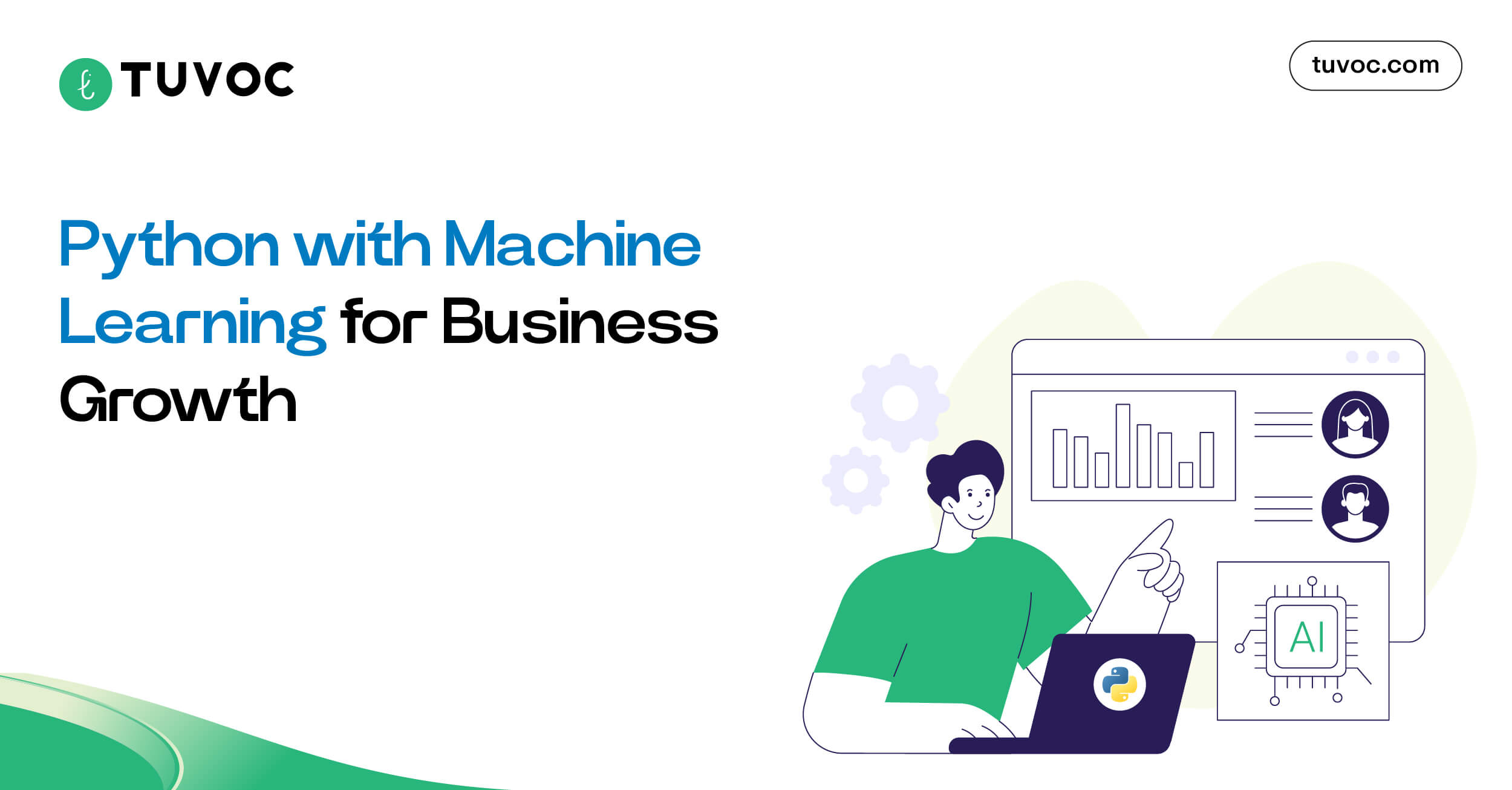In our daily lives, we are surrounded by advanced AI/ML models that help make our lives easier. From Alexa and Amazon to OTT platforms, chatbots, social media platforms, and industry-specific solutions, advanced AI/ML solutions have transformed user engagement and overall satisfaction. To develop these advanced solutions, businesses often rely on expert-led Python consulting services to strategically implement the right tools, frameworks, and ML models using the Python programming language.
Python is no longer restricted to web app development. It has become the first choice for AI/ML development, deep learning solution development, and interactive data visualization, facilitating a smooth analysis process.
Using Python with machine learning helps you to create easy-to-integrate solutions for streamlined image recognition, NLP, predictive analytics, fraud detection systems, and others.
Why Python for Machine Learning?
1. Rich Ecosystem of Libraries and Frameworks
Python offers a combination of diverse libraries and frameworks that help streamline the development process. Popular libraries for machine learning include Scikit-learn, Pandas, and NumPy. Frameworks include TensorFlow, PyTorch, and Keras.
These Python frameworks and libraries help you with data collection, manipulation, and model development. So, eventually, you can boost the development process with an agile approach and smooth management of tasks.
2. Pre-trained Models
Python libraries like PyTorch and TensorFlow provide enhanced access to pre-trained AI/ML models and scalable architectures. These pre-trained models require less training, which helps you to develop advanced learning models quickly and transfer learning.
There are diverse pre-trained models available like TensorFlow Hub, PyTorch Hub/Torchvision, Hugging Face Transformers, and Keras Apps.
3. Smooth Integration with Tools and Languages
You can easily integrate diverse tools and programming languages with Python. These enhanced capabilities help streamline integrations, data analysis, migration, and deployment.
4. Compatible with Diverse Industries
Python is the ideal language for machine learning development projects across industries. It helps in building futuristic solutions that automate complex business processes.
5. Rapid Prototyping
Integrating Python with Jupyter Notebooks and other libraries enables rapid prototyping. This allows you to perform smooth testing, iterate, predict results, and fetch valuable data insights. For example, The NumPy Python library provides boosted performance across various platforms.
6. Active Community Support
The global Python community helps boost the development process by sharing bet development practices, providing troubleshooting resources, and solving development challenges.
Popular Python Tools and Libraries for Machine Learning
As a prominent programming language for machine learning processes, Python facilitates the development and implementation of AI/ML in custom softwares. There are diverse Python libraries available that help you build enterprise-grade solutions.
1. NumPy
Numpy is the fundamental library used for data analysis, modeling tasks, and numerical computation. It helps you with fast computations necessary in scientific and ML projects.
2. SciPy
SciPy is a Python library that provides advanced scientific computing capabilities. You can use this for integration, optimization, interpolation, and linear algebra/mathematical calculations. It helps you to solve complex mathematical problems in ML workflows.
3. Matplotlib
Matplotlib is a data visualization library that helps you to create static, custom, and interactive visualizations across various formats. This library will help you with data analysis, data visualization, ML, and scientific research.
4. Scikit learn
Scikit learn is a versatile machine learning library that helps you with classification, regression, model selection, and dimensionality reduction. This advanced library provides consistent APIs that are easy to access and implement for both beginners and experienced Python developers.
5. Keras
Keras is an open-source Python library that helps in the training and development of neural networks. The primary benefit of using Keras is that it helps you build prototypes and execute them by implementing deep learning methods.
Real-World Applications of Using Python for Machine Learning
Python can be used for developing ML models customized to business needs. Combining Python for designing and building futuristic ML models that transform business processes. Here are a few popular applications of Python for ML model development.

1. Image and Speech Recognition
Python has helped in developing image and speech recognition systems by utilizing advanced libraries such as OpenCV, TensorFlow, Keras, and Scikit-image.
It mainly involves the development of applications like:
- Facial Recognition: It is used primarily in security systems, phone unlocking, authentication, and surveillance.
- Object Detection: Identifying and locating objects within an image or video (eg, cars, people, and animals)
- Image Classification: Categorizing the image based on its visual content (e.g., medical imaging, spam image detection).
2. Natural Language Processing (NLP)
Utilizing advanced libraries of Python for NLP, like NLTK, spaCy, Transformers, textBlob, and gensim, enables machines to understand, interpret, and generate human-like responses.
Sentiment Analysis
It helps in detecting the emotions and views in text (eg., positive, negative, and neutral), used in brand monitoring and customer feedback.
Chatbot and Virtual Assistant
Automate the customer support, assistance, schedule management process, preliminary project and inquiry management, and FAQs (popular assistants are Siri, Alexa, and support bots.
Language Translation
This helps you translate text or speech between languages (Google Translate is a popular example of a translator that works in real time).
Speech Recognition
It helps users convert spoken words into text (voice commands, transcription, and accessibility).
3. Recommendation Systems
Python helps you create recommendation systems using libraries like Scikit-learn, Surprise, and TensorFlow recommenders.
Online Shopping
Implementing recommendation systems in online shopping platforms that suggest products based on user behavior and preferences.
Streaming Services
Implementing recommendation systems in streaming and OTT apps helps your users to get movies, shows, or music based ontheir past history. For example, Netflix, Spotify, or Prime Video.
Social Media
Recommendation systems in social media help personalize content feeds and friend suggestions.
4. Fraud Detection and Prevention
Python’s ML and advanced data analysis tools are crucial in developing fraud detection models by using libraries like Pandas, Scikit-learn and Pytorch.
Financial Fraud
Implementing fraud detection and prevention models helps in detecting suspicious transactions using behavioral analysis and anomaly detection.
Credit Card Fraud
The advanced fraud detection and prevention approaches flag fraudulent usage patterns in real time using advanced supervised ML models.
5. Predictive Analytics
With the strong ecosystem of Python for data science, like NumPy, Matplotlib, Statsmodels, and Prophet. This enables businesses and researchers to make informed predictions about the future based on historical data.
Weather Forecasting
Using predictive forecasting helps in forecasting climate conditions and fluctuations using smart sensors and satellite network data.
Stock Market Analysis
Analyzing stock trends, volatility, and price fluctuations provides users with smooth financial insights. You can also hire Python developers to automate data compilation and analysis processes.
Business Performance Forecasting
Predictive analytics models help in estimating sales, growth, team performance, and demand to streamline the decision-making process.
What are the Most Common Limitations and Solutions of Python for ML?
Python is a prominent language for AI/ML development, but it has several limitations that create a major impact on performance, scalability, and responsiveness in ML projects:
1. Slow Execution Speed
As an interpreted programming language, Python is comparatively slower than other compiled alternatives like Java or C++. This largely impacts your development process of large-scale and real-time complex ML apps.
Solution
You can leverage Python libraries with Native extensions like NumPy, Pandas, Scikit-learn, TensorFlow, PyTorch, which are created over optimized C/C++ code. This helps you to implement high performance and easy execution.
2. High Memory Consumption
The dynamic code typing and flexible data structure result in higher memory usage, which makes it less suitable for memory-constrained projects or handling a large number of datasets.
Solution
You can use NumPy, Pandas, and other libraries that support vectorized and memory-efficient operations on large arrays rather than iterative loops.
3. Dynamic Typing and Runtime Errors
The static type of declarations leads to more frequent runtime errors that necessitate you to conduct rigorous testing and debugging. So, this is specifically common in complex ML pipelines and projects that require real-time debugging and quick execution.
Solution
- Use Python type hints (PEP 484) and static type checkers like Pyright or mypy to catch the errors before executing the program.
- You can rigorously implement unit and integration testing with pytest or unittest frameworks.
4. Design Constraints and Scalability
Due to its simplicity and high level of abstraction, Python sometimes struggles to provide you with smooth designing and scaling for complex or enterprise-grade ML systems.
Solution
To ensure a smooth development process, use microservice architecture by breaking large systems into smaller and easier-to-manage microservices. You can integrate Python with other languages for critical implementation.
5. Lower Mobile Performance and Edge Systems
Python is mainly less supported on mobile devices (Android, iOS) and embedded systems. This will restrict you from implementing ML models for mobile devices.
Solution
- You can use model conversion tools to convert the Python-trained models into mobile-supporting formats and inference engines (ONNX, TensorFlow Lite for Android/iOS, Core ML for Apple devices).
- You can adopt ML-enabled frameworks tailored for edge computing (TensorFlow Lite, PyTorch Mobile, TFLite Micro).
- You can transfer the essential inference code to the device’s native languages (Java/Kotlin for Android, Swift/Objective-C for iOS, C++ for embedded).
- To develop hybrid apps, you can use Python only for prototyping, then migrate to mobile/embedded-specific stacks for production.
Comparative Table
| Limitation | Overcoming Strategy | Alternative Languages |
|---|---|---|
| Slow Execution Speed | Use native libraries, Cython, and Numba | C++, Java, Julia |
| High Memory Consumption | Vectorization, Dask, PySpark | Java, C++ |
| Dynamic Typing/Runtime Error | Type hints, static analysis, testing/td> | Java, Scala, Haskell |
| Design/Scalability | Microservices, deployment platforms | Go, Java, Scala |
| Mobile/Edge System Support | Model conversion, native languages | C++, Java, Swift |
Python vs Other Languages for ML
There is several programming languages used for machine learning model development. But Python continues to lead the segment due to its simplicity, flexibility and robust ecosystem. Let’s evaluate the other technologies with Python for ML development.
Python vs R
Python is ideal for building end-to-end ML applications with enhanced features. It smoothly integrates specific databases, APIs, specific web frameworks, and cloud services.
R helps with statistical analysis, data visualization, and academic research. It is the preferred language among statisticians and data analysts for hypothesis testing, plotting, and exploratory data analysis.
Use R when your project is focused on data exploration, statistical modeling, and research-driven analysis.
Python vs Java
Python excels in development speed and streamlines experimentation, which is crucial for the development of ML models. Due to its simplified syntax and robust libraries like TensorFlow and Scikit-learn, Python helps you build prototypes faster and facilitates smooth iteration.
Java provides faster execution and easy memory control, which makes it suitable for developing high-performing apps like real-time systems, big data processing, and financial platforms.
Use Java when you are building enterprise web apps and performance sensitive systems like fraud detection engines or credit score test platforms.
Python vs Julia
Despite being slower in execution, Python offers you a more mature ML ecosystem and greater flexibility. This makes it an ideal choice for most ML projects.
Julia, on the other hand, helps you to build high-performing numerical computing and is most suitable for tasks that demand high-speed processing and mathematical precision, like computational physics and scientific simulations.
You can use Julia when working on mathematically complex algorithms and large-scale numerical simulations where speed is a core requirement.
Python vs C++
C++ is known for providing maximized performance and low-level hardware control, which is beneficial for GPU-intensive or real-time ML environments such as robotics and autonomous systems.
Python helps in reducing the development complexity and time with its high-level syntax and wide range of ML libraries. This allows you to make it go to the language for most of the teams and projects.
Use C++ when you are developing performance first systems like embedded AI, real-time computer vision, or hardware accelerated inference.
Conclusion
The transforming business era is more focused on implementing ML applications into their routine processes. These systems help in the data-driven decision-making process using structured datasets.
The robust libraries, tools, and strong community support make it ideal for both beginners and experts aiming to develop scalable and smart solutions. While other languages like R, Julia, Java, and C++ have their advantages, Python establishes the perfect balance between ease of use and smooth implementation.
Whether you are prototyping a model, implementing features, or working with Python integration and migration services to embed ML into web platforms or third-party tools, utilizing Python helps you unlock smarter insights, automate workflows, and drive innovation throughout the organization.
FAQs
Python is a widely used programming language for ML due to its simple syntax, extensive libraries (like Scikit-learn, TensorFlow, and PyTorch), and huge developer community. It facilitates rapid development, smooth integration with other technologies, and ongoing support for data handling and visualization.
Python is surely among the top languages of machine learning and AI. It provides clean syntax, great community, and a rich library ecosystem including TensorFlow, PyTorch, and Scikit-learn. Python can effectively be used to develop, train, and execute smart systems.
There are mainly four types of machine learning, which include reinforcement learning, unsupervised learning, supervised learning, and semi-supervised learning. These categories are highly dependent on how the learning algorithm is implemented or trained and the types of data it utilizes.
The ML pipeline significantly involves Python, which includes data preprocessing, model training, evaluation, and deployment. Its libraries make implementing algorithms easy, whereas it has the flexibility to be used with web apps, APIs, and cloud platforms. Python accelerates the ML development process in all aspects.
With the help of strong frameworks such as TensorFlow, Keras, and PyTorch, Python is the most preferred language for deep learning. They are easy libraries to train and create neural networks for image recognition, NLP, etc.
Yes. Python is well-suited to develop real-time ML applications such as fraud detection, recommendation systems, and chatbots, particularly when used along with fast backend services and message queues or microservices. However, in low-latency systems, languages such as C++ or Java can be utilized, but with specific requirements for these languages to run simultaneously.
Have an Idea? Let’s Shape It!
Kickstart your tech journey with a personalized development guide tailored to your goals.
Discover Your Tech Path →Share with your community!
Latest Articles

Trading System Architecture 2026 | From Microservices to Agentic Mesh
Exclusive Key Takeaways: Agentic mesh replaces microservices to minimize network hop latency. Edge-native compute moves execution logic closer to exchange…

Trading Platform Development | Cost vs. ROI in 2026
Introduction - The Real Price of Building a Trading Platform in 2026 There is uneasiness among investors worldwide. The uncertainty…

The Ultimate Trading Platform Development Checklist
Unique Takeaways: The Build vs. Rent Verdict:Why custom trading software development is the only path to owning your IP and…


